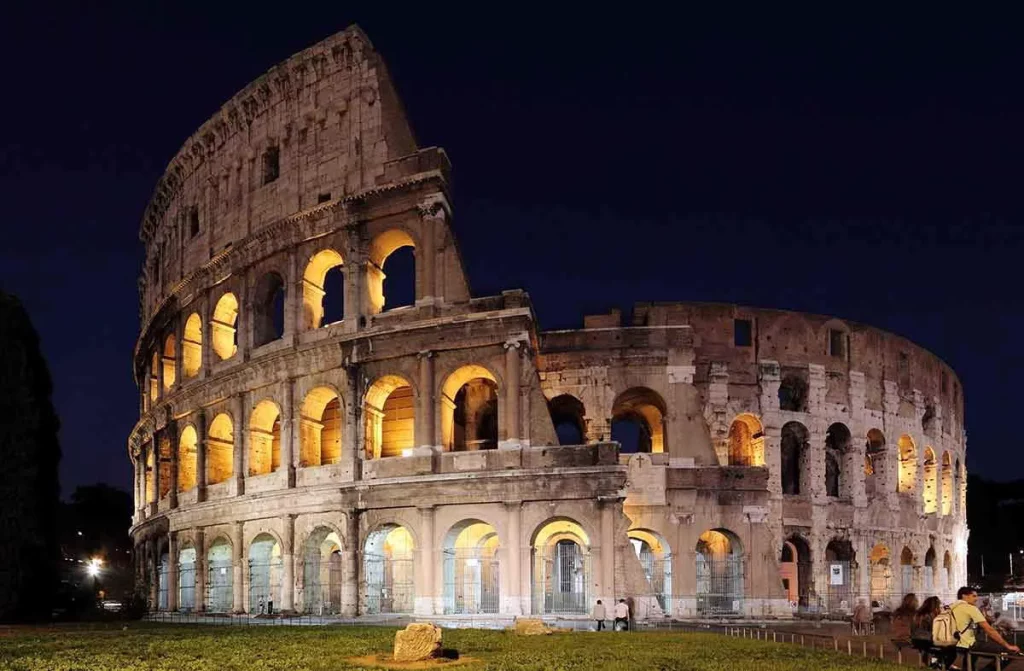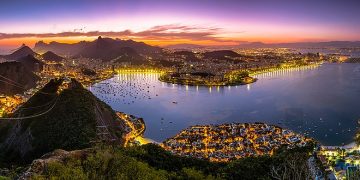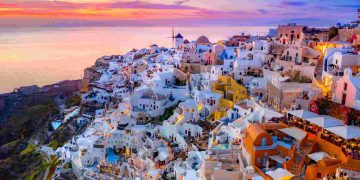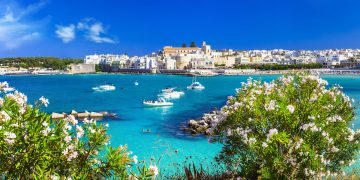Introduction: The Colosseum and Its Surroundings – An Ever-Evolving Landscape
The Colosseum, one of the most iconic structures in the world, is much more than a symbol of Ancient Rome’s imperial grandeur. Situated in the heart of modern-day Rome, it offers a fascinating glimpse into the ancient past while interacting dynamically with its current natural surroundings. As a visitor stands before its grand arches, one can’t help but marvel at not just the Colosseum’s architectural feats but also the natural landscape that has grown around it over the centuries. This unique intersection of history and nature enhances the visitor experience, offering a holistic view of what the Colosseum represented and how it remains connected to the natural environment.
In this article, we will explore the natural scenery surrounding the Colosseum and examine how this landscape enhances the overall experience for visitors. From the Roman Forum’s ancient olive trees to the lush greenery of Palatine Hill and the Roman Gardens, we will uncover how the natural elements contribute to the beauty and significance of the Colosseum and its surroundings. We will also look at how environmental changes, urban development, and historical events have influenced the current state of the area, providing a deeper understanding of the site’s enduring legacy.
1. What is the Geography and Natural Setting of the Colosseum?
The Ancient Landscape of the Colosseum
The Colosseum, originally known as the Flavian Amphitheater, was built in the 1st century AD on the site of a former lake in the Nero’s Domus Aurea (Golden House). The location was carefully chosen to showcase not only the might of the Roman Empire but also its proximity to natural landmarks. The Colosseum sits at the base of Palatine Hill, one of Rome’s Seven Hills, and offers expansive views over the Roman Forum and the surrounding areas.
Palatine Hill and Its Vegetation
- Palatine Hill, one of the oldest areas of Rome, is known for its historic significance, as it is the legendary location where Romulus and Remus were said to have been raised by a she-wolf. Today, it is also home to gardens, ancient ruins, and vegetation, including trees such as olive trees, cypress, and pine trees that provide a natural canopy over the archaeological site.
- The hill’s elevated position offers a stunning panoramic view of the Colosseum, the Roman Forum, and the broader cityscape of Rome. Visitors often climb to the top of Palatine Hill for a peaceful moment surrounded by nature, offering a reprieve from the crowds.
Roman Forum and Its Green Spaces
- The Roman Forum, which lies just adjacent to the Colosseum, is another site where history and nature converge. This sprawling area, once the heart of the Roman Empire’s public life, is dotted with wildflowers and vines, especially in the spring and summer months.
- The green spaces within the Roman Forum offer a lush contrast to the stone ruins, creating a tranquil environment that allows visitors to step back in time and imagine what the area once looked like—alive with activity and surrounded by nature.
The Colosseum’s Influence on the Surrounding Environment
Over the centuries, the Colosseum has influenced its surrounding environment in several ways. From its role in water management to the way it has become integrated into the urban fabric of Rome, the Colosseum has always been in dialogue with the natural landscape.
- The hypogeum (underground) of the Colosseum, where gladiators and animals were kept before combat, is another testament to Roman engineering. This underground area is connected to the city’s water system, and the aqueducts that once fed the Colosseum are a marvel of ancient technology that also worked in tandem with the natural environment.
2. How Does the Flora Around the Colosseum Contribute to Its Appeal?
Gardens and Greenery
While the Colosseum itself is primarily an architectural marvel, it exists within a landscape that includes some of Rome’s most beautiful gardens and natural spaces.
The Roman Gardens
- The Roman Gardens, located near the Colosseum, are a serene spot where nature blends seamlessly with the historical ruins. This area is often overlooked by tourists, making it an excellent place to find respite from the bustling crowds. The gardens feature lush flower beds, fountains, and shady spots, where visitors can relax and take in the natural beauty of the area.
- Wildflowers and grasses grow naturally in this region, and climbing plants such as ivy have taken root on the ancient walls of nearby ruins. These plant species not only enhance the visual appeal but also contribute to the preservation of the site, as their roots help stabilize the soil.
The Role of Olive Trees and Cypress
- The olive tree has deep cultural and historical significance in Italy and the Mediterranean. Throughout Rome, including in the Colosseum area, olive trees grow freely in public spaces and ancient ruins. They provide shade and an atmosphere of tranquility.
- Cypress trees, with their tall, slender appearance, are another prominent feature of the Roman landscape and are often associated with ancient cemeteries and sacred spaces. The Colosseum’s proximity to these trees enhances its solemn and awe-inspiring atmosphere.
Urban Landscaping and Preservation Efforts
Over time, the area around the Colosseum has been subject to urban development, but efforts have been made to preserve the natural environment. Various landscaping projects and restoration efforts aim to maintain the integrity of the space, ensuring that both the historical and natural elements are protected for future generations.
- Today, green spaces around the Colosseum are carefully maintained to highlight the natural beauty of the site while also preserving the ancient ruins. These spaces offer a contrast to the ruins, showing how nature has grown alongside the Roman legacy.
3. How Does the Colosseum’s Natural Surrounding Change with the Seasons?
Seasonal Changes in the Colosseum’s Environment
One of the most interesting aspects of the Colosseum is how its surroundings change with the seasons. Different times of the year provide unique opportunities to experience the Colosseum and its natural setting from different perspectives.
Spring: Blossoming Flowers and Vibrant Greenery
- In spring, the Roman Forum and Palatine Hill come alive with wildflowers and the lush greenery of fresh foliage. This is the perfect time for nature lovers to visit, as the combination of the ruins and blooming flowers creates a beautiful and serene landscape.
- Cherry blossoms, poppies, and lavender are some of the flowers that can be found in the surrounding gardens, adding color and fragrance to the air.
Summer: A Bustling, Sun-Kissed Landscape
- During the summer months, the Colosseum’s natural surroundings take on a dry, sun-drenched look. The Mediterranean heat turns the grass and flowers into a more muted palette of golden hues. However, the trees provide much-needed shade for visitors.
- The area around the Colosseum becomes particularly vibrant in the evenings, with the golden sunlight casting long shadows across the ruins, making for a stunning visual experience.
Autumn: Crisp Air and Fall Colors
- Autumn is another fantastic time to visit, as the changing leaves on the trees around the Colosseum create a picturesque scene of orange and red hues. The crisp autumn air also adds to the charm, creating a more comfortable environment for exploring.
- Visitors can enjoy quieter moments in the surrounding parks, where the air is fresh and the crowds are thinner.
Winter: A Quiet and Reflective Time
- Winter, while colder, offers a more peaceful experience. The Colosseum and its surrounding natural scenery become quieter and less crowded, allowing for a more reflective visit. The trees around the Colosseum are bare, revealing the structural beauty of the ruins and providing an opportunity to appreciate the monument without the distractions of foliage.
- The winter months also offer a unique opportunity for photography, as the Colosseum is often dusted with snow or bathed in the soft light of the winter sun.

4. How Does the Natural Scenery Reflect Roman Beliefs and Architecture?
The Symbolism of Nature in Ancient Roman Culture
Romans placed great importance on nature and its connection to their cultural and religious practices. The natural elements surrounding the Colosseum were not just for aesthetic purposes; they were also deeply symbolic.
Cultural Symbolism of Trees
- Olive trees, in particular, symbolized peace, prosperity, and longevity in Roman culture. The presence of olive trees around the Colosseum and other sacred sites may have been symbolic of Rome’s divine connection to these ideals.
- Cypress trees, often associated with death, served as a reminder of the transient nature of life. Their presence around the Colosseum created a poignant atmosphere, enhancing the solemnity of the games and public spectacles held there.
Integration of Nature and Architecture
- The Romans were adept at integrating nature with their architecture.
This was evident in the gardens and natural features surrounding the Colosseum, where pathways, arches, and water features interacted seamlessly with the surrounding plant life.
Conclusion: The Colosseum as a Harmonious Blend of History and Nature
The Colosseum, while primarily a monument to Roman architecture and engineering, exists in a dynamic environment where nature and history intertwine. The natural scenery surrounding the Colosseum—from the historic trees to the gardens and hills—creates a setting that enhances the visitor experience. Whether it’s the tranquil beauty of Palatine Hill, the changing seasons, or the symbolic significance of the flora, the natural landscape invites visitors to reflect on both the grandeur of Ancient Rome and the enduring power of nature.
This harmonious blend of architecture, history, and nature makes a visit to the Colosseum not just an exploration of the past but a chance to witness the enduring beauty of the environment that surrounds it.





















